Brasil
GET READY, BRAZILIAN BEAUTIES
WILL SURPRISE YOU!
STATES
Check out the main tourist attractions of important Brazilian destinations






GET READY, BRAZILIAN BEAUTIES
WILL SURPRISE YOU!
Check out the main tourist attractions of important Brazilian destinations





If you still don’t know Brazil, then you need to start planning your trip. Did you know that every year, the American newspaper
The New York Times publishes its traditional list with 52 destinations that must be visited and for 2023, the publication points out two places in Brazil: Lençóis Maranhenses National Park, in Maranhão, and Manaus, capital of Amazonas, were ranked 11th and 41st, respectively.
Another international publication, this time from the Make It website, which is part of the American conglomerate CNBC, placed Rio de Janeiro in the list of seven destinations in the world to visit before you die. The “Cidade Maravilhosa” (Wonderful City) occupies the 5th position in the ranking, behind of some tourism giants such as Paris (France), Rome (Italy), New York (United States) and Cape Town (South Africa), and ahead of Tokyo (Japan) and Istanbul (Turkey).
And that’s not all, the famous Travellers’ Choice award, from TripAdvisor, which reveals travelers’ favorite destinations, hotels, restaurants and activities based on the ratings and opinions collected from people
all over the world, included two Brazilian cities in the 2023 lists: Rio de Janeiro and São Paulo. The capital of Rio de Janeiro is in the 25th position among the “World’s Most Popular Destinations”. The publication points out that with its stunning beaches and dramatic mountains, as well as samba and bossa nova as soundtrack, it is easy to fall in love with Rio de Janeiro. São Paulo ranks 24th among the “Best Cultural Destinations in the World”. The highlight is São Paulo’s cuisine and art. According to travelers, South America’s largest city is as multinational as its diverse population of more than 11 million people.
In other words, there is no lack of reasons for you to pack your bags now and set off for Brazil. If you are still not convinced, we invite you to read the following pages and discover the enormous variety of possibilities that our country offers. From North to South, East to West, we have an infinite number of tourist attractions. It’s time to get to know our country. Enjoy your reading!
Enjoy your reading!
President Roy Taylor
Vice-President Rosa Masgrau rosamasgrau@mercadoeeventos.com.br(55-11) 4862-6875 - (55-21) 2254-3543
Editorial Director
Natália Strucchi natalia.strucchi@mercadoeeventos.com.br(55-21) 99164-2940
Chief Editor Pedro Menezes pedro.menezes@mercadoeeventos.com.br(55-11) 97863-2020
Sales Director Mari Masgrau mari.masgrau@mercadoeeventos.com.br(55-11) 4862-6875
Administrative and financial director
Roberta Saavedra roberta.saavedra@mercadoeeventos.com.br(55-21) 2487-1616
Operational Andreia Boccalini andreia.boccalini@mercadoeeventos.com.br(55-11) 4862-6875
Reportage
Janaina Brito janaina.brito@mercadoeeventos.com.br
Ana Azevedo ana.azevedo@mercadoeeventos.com.br
Rafael Torres rafael.torres@mercadoeeventos.com.br
Photographer Eric Ribeiro eric.ribeiro@mercadoeeventos.com.br
Designer Patrick Peixoto
Reportage SP (55-11) 4862-6875 | Reportage RJ (55-21) 2254-3543
Costumer Service (55-11) 3138-6273
Infrastructure Management IT WorkNet Tecnologia fernando.carilo@worknetecnologia.com.br Internet Management GRM Internet e Serviços (55-21) 3993-8492
Comercial Department
São Paulo (55-11) 4862-6875 | Rio de Janeiro (55-21) 2254-3543
São Paulo Rua 24 de Maio, 276 - 3º andar (55-11) 4862-6875
Rio de Janeiro Avenida das Américas, 14.591Grupo 403 - Cep 22790-701 (55-21) 2487-1616
A publication of the Editora Mercado & Eventos Ltda
The articles and opinions of third parties published in the edition do no necessarily reflect the position of the newspaper
 Ouro Preto
Ouro Preto
OFFICIAL NAME: Federative Republic of Brazil
GOVERNMENT SYSTEM: Federative Presidential Republic
PRESIDENT:
Luiz Inácio Lula da Silva
CAPITAL: Brasília
OFFICIAL LANGUAGE: Portuguese
LOCATION: South America
AREA: 8,516 million km²
POPULATION: 212.6 million
CITIES: 5.570
DIVISION:
Brazil is divided into five regions with 26 states, plus the Federal District (DF)
BIGGEST CITIES:
TOP 3 MAIN MARKETS
THAT SEND TOURISTS TO BRAZIL IN 2022:
1. ARGENTINA (1.032.762)
2. UNITED STATES (441.007)
3. PARAGUAY (308.234)
São Paulo, Rio de Janeiro, Porto Alegre, Belo Horizonte, Fortaleza, Recife, Salvador, Curitiba, Florianópolis, Manaus and Brasília
OFFICIAL TIME ZONE IN BRAZIL: GMT - 3
INTERNATIONAL PHONE CODE: +55
OFFICIAL WEBSITES: www.brasil.gov.br and www.turismo.gov.br
MINISTER OF TOURISM: Daniela Carneiro
PRESIDENT OF EMBRATUR: Marcelo Freixo

OF CONCERTS AND CONGRESSES.
Capital of culture and business, São Paulo is the premium destination for events. There is a series of convention centers, venues, exhibition halls, hotels and resorts. Your event will remain in the memory forever. São Paulo annually receives all formats and sizes of events. Come and choose your best option.
 Secretaria de Turismo e Viagens
Secretaria de Turismo e Viagens
Secretaria de Turismo e Viagens
Secretaria de Turismo e Viagens
GERMANS ARE LOOKING FOR SUN AND BEACH DESTINATIONS (55.6%),
CULTURAL ATTRACTIONS (20.8%) AND ECOTOURISM OR ADVENTURE (20.4%)
most important global tourism destinations”, she points out.
According to the Minister of Tourism, promoting the expansion of Brazil’s air connectivity with the world is fundamental to position Brazil as a reference destination in the international market.
Portugal, France, Germany, Spain, and the UK are the main senders of European tourists to Brazil. Before the Covid-19 pandemic, Brazil received almost 1 million tourists per year from these five countries. Last year, 500,000 - or half this number, were registered.
“Under President Luiz Inácio Lula da Silva’s government, together with the Brazilian Agency for International Tourism Promotion (Embratur), we will work hard to regain space in the world scenario and increase the interest of European tourists as well as tourists from other continents in getting to know Brazil”, guarantees the new Brazilian Minister of Tourism, Daniela Carneiro.
Less than three months in office, she is enthusiastic about the work that lies ahead. “We have a real commitment to structure our destinations and stimulate safe and responsible tourism. Brazil is back and with open arms to receive tourists from every country in the world”, she guarantees.
According to Daniela, an action plan has been created for the first 100 days of work, and the green and sustainable agenda is one of the strong points, considering the wealth of natural beauty and unique biodiversity that Brazil has. “Our goal is to establish Brazil as one of the
“Countries like Portugal, France and Germany are already among the 10 largest emitters of tourists to Brazil. However, it is important that we offer new routes to attract visitors from other countries as well. This is a dialogue that we are trying to initiate both with authorities from other countries and with airline companies, and that will be permanent during my administration”, explained Daniela.
Daniela Carneiro also points out that international fairs, such as the ITB, are spaces in which it is possible to present Brazil to the world, encouraging more international tourists to visit the country.
“Germany is one of Brazil’s important tourist partners. Last year, we registered more than 120 thousand German tourists in Brazil. Nevertheless, we believe that we can further expand tourism between our countries. Before the pandemic, in 2019, seven out of 10 German tourists came to Brazil for the second or more time. Hospitality and gastronomy were the great highlights in the opinion of German visitors,” she concludes.

Last year we registered more than 120,000 German tourists in Brazil. Nevertheless, we believe that we can expand even more the tourism between our countriesDaniela Carneiro, Minister of Tourism
ARGENTINES (1,032,762), AMERICANS (441,007) AND PARAGUAYANS (308,234)
WERE THE ONES WHO VISITED BRAZILIAN DESTINATIONS THE MOST
international visitors here”, says the president of Embratur.
More than 3.63 million international tourists visited Brazil in 2022. The arrival of foreigners in the country increased almost five times compared to 2021. Despite the high, the number is still 43% lower than the number recorded in the pre-pandemic period. According to the Ministry of Tourism survey, Argentines (1,032,762), Americans (441,007), and Paraguayans (308,234) were those who most visited Brazilian destinations over the past year.
Brazil’s participation in this ITB will follow the stand and distribution model that was already being used last year, a situation that should be modified starting in November. “I want a new model to work, emphasizing the integration between Embratur and the states. The promotion of our country cannot be done in an isolated way. We are going to requalify Brazil’s participation in the fairs”, guarantees the new president of the Brazilian International Tourism Promotion Agency (Embratur), Marcelo Freixo, who took office in January.
“Tourism is food on the plate. Tourism is development, it is income. We need the world to visit Brazil again. The Brazil that we want is the Brazil that we have to show to the world. Embratur is decisive and strategic for this”, Freixo evaluates.

Among the points that will guarantee the increase of international visitors is the expansion of airline connections between Brazil and abroad, including Europe. “I have already met with the main companies that operate in our country. The airlines today are much more concerned about taking Brazilians abroad than bringing tourists. I think it’s great, but what will generate jobs and income is to bring
Among the top 25 outbound tourists to Brazil, Portugal and Ireland are the markets that showed the best recovery from the effects of the pandemic, reaching 85% recovery compared to 2019. Portugal’s strong recovery has moved the country up from ninth to sixth position in the ranking of the largest markets for international tourism to Brazil.
“We are at the current level of three million and our goal is to double this now, reaching six million and then pass this amount. Without any doubt, with this pact that we are making with the entire civil society of tourism, we will succeed”, says Freixo.
According to official data, these international tourists spent US$ 4,952 billion in Brazil in 2022, representing a 68% growth in relation to the previous year, when US$ 2,947 were counted, demonstrating recovery in the sector. The numbers also shows a 62.6% increase compared to 2020, the year of the start of the Covid-19 pandemic.
“ “
Marcelo Freixo, presidente da EmbraturFoto: Eric Ribeiro
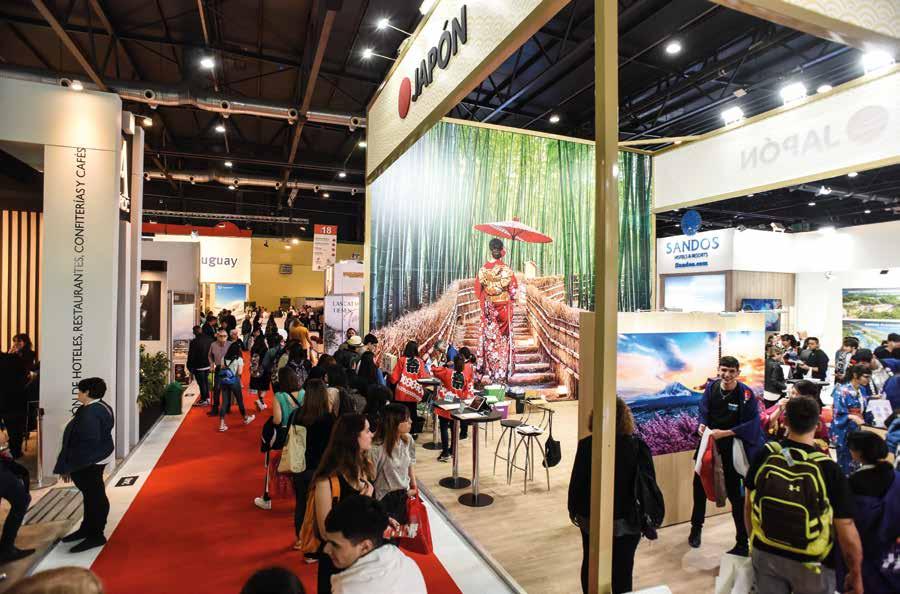

ady notices the good reflexes. In 2022, technical-scientific events represented 40% of the demand, fairs and congresses corresponded to 23% each, and there was also a volume of 15% for other niches. In the year, in total, São Paulo had 1,003 events. With the hybrid format we have more room to capture international events, which do not need the physical presence of the host, since he can participate live digitally”, explains the leader.
The State of São Paulo has registered in 2022, an almost total recovery in relation to 2019, the last year before the pandemic, both in the leisure and business segments. All this is a reflection of the work that has been done to promote and attract new business and new audiences.
“The participation of São Paulo in international fairs is fundamental to show the attributes we have and to bring more tourists to Brazil, increasing the flow of foreigners visiting our state and also the entire country”, evaluates Toni Sando, executive president of the São Paulo Convention & Visitors Bureau (SPCVB) and of the National Union of CVBs and Destination Entities (Unedestinos).
According to him, it is very important for Brazil to be abroad, since the pandemic and some strategies that were not successful left Brazil off the destination’s shelf. “We are organizing ourselves as Unedestinos so that we can participate in the fairs that Embratur proposes, organizing ourselves to be promote products and so that all of us, in a general way, CVBs and players, can become a kind of ambassadors of Brazil in these international fairs”, reveals Sando.
According to him, in 2023, São Paulo has, so far, about 260 registered events, with a forecast of reaching 1,600 events by the end of the year. “Our demand is already very similar to the 2019 volume, even with an increase and the hotel occupation alre -
Toni Sando reveals that the expectation is to reach the 2019 numbers. “We are working together to make a unified work with the state and municipal governments. It is the sum of public and private invest ments, working together with the same line, the same identity, so that we can bring more and more visitors to our destination”.
For the executive, the investments in promotion of the destination, publicity, ro adshows, participation in the main fairs and events with the positioning of “SP Para Todos”, in public/private actions, have put São Paulo in the spotlight again. “We are excited about the continuity of actions in the new management. There is a lot to be done, such as revenue recovery, hiring and training, but with this scenario, the diffi culties have become opportunities for ad justments and investments,” he concludes.
We are working together to make a unified work with the state and municipal governments. It is the sum of public and private investments, working together with the same line, the same identity, so that we can bring more and more visitors to our destination




To embark on this gustatory journey, we have the traditional feijoada, which represents the state of Rio de Janeiro. According to history, the dish was created by the black slaves in the XIX century, who cooked the less noble parts of the pig and due to its outstanding flavor, it fell in the popular taste. The dish includes black beans, carne-seca, pork ear, tongue, tail, loin, sausage, and ribs, which are served with white rice, cabbage, farofa (toasted cassava flour), cracklings and orange. The meal is very common at gatherings of family and friends, usually eaten on weekends, holidays or commemorative dates.


As in a recipe, we can say that the Brazilian culinary portrait takes an indigenous dose, an African handful, a European cup, and a pinch of Latinity. There is no doubt that the country’s gastronomy is one of the richest and tastiest in the world. If we divide it by region, the North has fish, manioc, chestnuts, açaí and cupuaçu as main ingredients. In the Northeast, carne de sol, butter-from-a-bottle and rapadura are the highlights. The Midwest uses a lot of fish, flour and chicken in their dishes. The Southeast also uses cheese, meat, shrimp and vegetables. Finally, the South is known for its high consumption of red meat, especially on the barbecue, as well as a lot of wine and mate, made with yerba mate, which results in a type of tea. To get an idea of the gastronomic diversity, we have separated some of the most loved dishes. Check them out!

With a strong and striking flavor, Acarajé is intimately linked to African culture and in the native language means “to eat fireball. The food is made of a small ball of refried beans, seasoned with onion and salt, fried in dende oil and stuffed with vatapá (coconut milk, cashew nuts, peanuts and shrimp), vinaigrette, and dried shrimp.
The use of pepper is very appreciated and here’s a warning: if you are asked if you want your acarajé cold or hot, the person is not referring to the temperature in which it is served, but to the amount of pepper you will put on it. The food is easily found all over the country, but especially in the city of Salvador in Bahia.
“Carreteiro Rice” is a dish made in an iron pot and mixes rice with sun dried meat stew. The recipe is practical, easy, and works, because it brings a feeling of satiety quickly without the need for large quantities of consumption. Its history is related to the lonely travelers who transported cattle and had no way to store large volumes of ingredients or prevent them from rotting, hence the use of rice and meat preserved in salt and dehydrated in the sun.
Very well known nationally, the bobó is made with shrimp sauteed in coconut milk, dendê oil, green seasonings and manioc purée. The composition of the dish is a mixture of African and indigenous culture, created in Brazil. Believe me, the flavor is incomparable!
In Espírito Santo, the moqueca capixaba is the main flavor of the state. The dish is prepared in a clay pot and consists of fish cooked with seafood, Urucum, Malagueta pepper, tomato and green seasonings. It is served with white rice and Pirão.
Popular in the state of Ceará, the Baião de Dois is a dish of rice, french beans, dried meat, coalho cheese and butter-from-a-bottle. Its name makes reference to the “baião”, a typical dance of a musical rhythm spread by Luiz Gonzaga, a famous northeastern singer all over the country.
Representative of the Minas Gerais cuisine, the chicken with okra is served with rice, beans, cassava flour, and polenta without sauce, or angu as it is called in the country. The recipe dates back to a time when it was difficult to transport food, with chicken and okra easily accessible.
One of the favorites of the inhabitants of São Paulo, the “Virado à paulista”, which is even an intangible heritage and it consists of rice, beans thickened with flour, crackling, pork steak, cabbage, sausage, fried eggs and bananas. The symbology of the name is related to the way meat was transported in the 17th century, which caused the food to be mixed and turned over. Popularly, this specialty is eaten on Mondays, when it is highlighted on restaurant menus.
In the Amazon, because of the abundance of fish in the rivers, the barbeque-roasted Tambaqui is widely consumed. The recipe uses lemon, salt and butter for seasoning, and the finishing touches are sugar cane molasses and Amazon Robusta coffee. It is without a doubt an unique dish!
A national passion and present at many weekends during family and friends reunions, the beef barbecue is one of the main dishes of the Brazilian cuisine and the main dish of the state of Rio Grande do Sul. Served on a spit or cut into slices, it is always accompanied by white rice, farofa (cassava flour), and salads, such as vinaigrette (tomato, onion, and cilantro-based) or mayonnaise, which includes several vegetables.
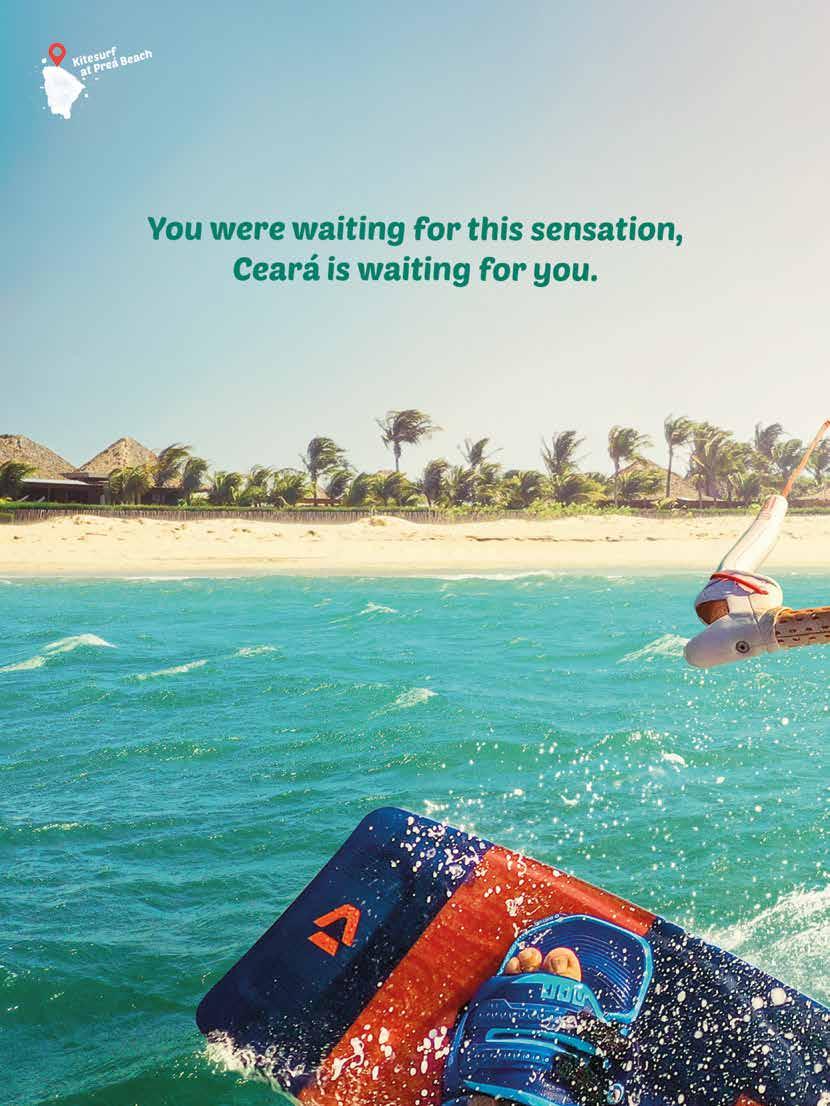

When we think of Brazil, liveliness, joy, culture, and popular festivities immediately come to mind. In fact, Brazilians love to ce-


And there is no way to talk about parties without mentioning Carnaval. One of the most awaited moments of the year by the population, it takes place between February and March, moving people from all over the country and even abroad. The date may vary, as it is celebrated 47 days before Easter. Where to celebrate? The answer is: from North to South, East to West! However, Bahia, Pernambuco, Rio de Janeiro, São Paulo, Santa Catarina and Minas Gerais are the states that stand out for the highest rate of demand.
The festivities is marked by the samba school parades, which annually prepare a spectacle in the sambodromes and compete among themselves about who has the best story, theme, allegory, music, and of course, a lot of samba. In the streets, the hot summer days serve as a backdrop for the passing of electric trios with shows by popular artists, colorful make-up, costumes, carnival parades, and a lot of joy in the midst of a sea of people! That’s right, the popular passion takes thousands to the streets.
lebrate and we have in our calendar several remarkable dates, which are the fruit of the cultural miscegenation that forms the nation.
The Festival of São João pays homage to the Saints: Santo Antônio, São João, São Pedro, and São Paulo during the entire month of June, dedicating each weekend to one saint. The cuisine is the main attraction, but there is also the traditional square dancing to the sound of typical music and the heat of the bonfire. The Northeast of Brazil is the region with the biggest festivals in the country, which can be enjoyed in Salvador, Bahia; in Caruaru, Pernambuco; and the biggest one is in Campina Grande, Paraíba. Other remarkable characteristics are the decoration and the costumes, as well as the games.
In the North of the country, in the city of Parintins, Amazonas, where the Amazon forest is located, the Parintins Folkloric Festival takes place, one of the most beautiful folk festivals in the world. In it, the iconic Boi Caprichoso (Caprichoso Ox) represented by the color blue, and Boi Garantido (Garantido Ox), represented by the color red, compete for the position of most beautiful in a parade that adds allegories, scenery, choreography, costumes, music and a lot of charisma.
Congada, or Congo, is another festivity that is worth getting to know. With no fixed day, it takes place between the months of May and October, depending on the region, and celebrates the entities of Nossa Senhora do Rosário, São Benedito, and Santa Efigênia. The festival is the result of African and Catholic cultural and religious elements union, translated into song, dance, interpretation and clothing. One of the most remarkable points of the occasion is the representation of the coronation of a king or queen of the Congo. The popular festival originated in Brazil in the middle of the 17th century, promoted by slaves, is one of the most outstanding folkloric manifestations in the country’s history. To enjoy it, the tip is to go to the states of Goiás, Minas Gerais, Paraíba, Pernambuco and Paraná.

Recognized as a Cultural Heritage of Brazil, the festival takes place in the Bumbódromo, a type of stadium that is shaped like an ox’s head and can hold 35 thousand people. The dynamics of the event is very similar to Carnaval, with competition among the participants and the champion parading through the city streets. The event lasts three days and takes place annually in the last week of June.

Brazil’s biggest country festival, the Barretos Cowboy Festival takes place in August, in the countryside of São Paulo. The event gathers more than 50 thousand people annually to watch the rodeo, besides having fun in the “berrante” (Cowbell) contest, in which the participants are evaluated by the instrument’s touch. There are also games such as the Pau de Sebo, a nine-meter high pole soaked in ox fat and with a cash prize on top. The challenge is to climb it and get the money back. The cuisine and music are also present, offering several typical dishes and treats, as well as performances by the main Brazilians country singers.


Traveling through Brazil is synonym of fun. In addition, to complete the experience, which goes far beyond sun, sea, natural parks, and museums, there are several theme parks prepared to enter-
Inspired in the stories of the Brazilian cartoonist Maurício de Souza, the Parque da Mônica is located inside the Shopping SP Market, in the city of São Paulo. There, the comic strip characters are represented in the decoration as well as in its 22 toys and attractions. Children of different age groups can take pictures and play with the main characters.
One of the Brazilians’ favorites, Beto Carrero World, in Santa Catarina, has extreme roller-coasters, train rides, interactive restaurants, and performances that mix music and theater. The establishment is ideal for families to spend the day having fun. In 2021 alone, more than 1.8 million visitors circulated there, surpassing Six Flags Mexico, which was the leader until 2019, in the pre-pandemic.
tain the adults and the children. Brazil is home to seven of the most visited theme parks in Latin America. Are you curious? Then check out this list with some of the best parks in the country.
The city of Olímpia, in the state of São Paulo, has several water parks, but the highlight is Thermas dos Laranjais, with 55 attractions, including water slides, slow river, waterfalls, Jacuzzis and private areas for families, it guarantees unforgettable memories. The park is supplied with natural hot water in temperatures from 78.8º to 100.4º.
The Playcenter brand is part of the affective memory of thousands of people in the city of São Paulo. Years after the closing of the original park, the Family version was created, located inside Shopping Aricanduva, offering attractions for children of all profiles, from those who prefer the playful to those more radical. The space has a roller-coaster, a Viking boat, a carousel, a go-kart, and lots of games.
 Photo: Renato Soares - MTur
Photo: Divulgação
Photo: Renato Soares - MTur
Photo: Divulgação
Gramado is becoming one of the biggest thematic attractions poles in Brazil and that’s where Snowland, the first indoor snow park in Latin America, is located.

Can you imagine playing in thermal waters with a 99.5º temperature? At Hot Park you can. The water park is one of the most famous in the country, which has 18 attractions, ranging from radical adventures, to diving or relaxing moments in the hot waters.
Close to São Paulo, one of the biggest cities in Brazil, Wet’n Wild is an oasis near urbanization, with more than 25 attractions. The highlights are the Meteor water slide, the 4th highest water slide in the world, and the Vortex, a huge and colorful funnel where the bather falls into the water.
In the city of Gramado, in Rio Grande do Sul, Alpen Park is the perfect option for those who want adrenaline. There are tree climbing activities, zip line, roller coaster, elevator, 4D cinema, go-kart, quadricycle, children’s area, and the sleigh - a toy that goes down the mountain at high speed, making people scream, laugh, and gasp. It’s worth a try!
One of the most famous water parks in Brazil, Beach Park has amazing attractions, such as an eight meters high slide, slow river, pirate treasure, waterslides and, next to it, a hotel complex, which offers advantages to the guests, such as early admission.


With the slogan “The happiest “country” in the world”, Hopi Hari is the ideal option for those who are in the city of São Paulo and want a little adrenaline. The attraction has a Ferris wheel, a wild river, roller coasters, movies, simulators, and Halloween and Christmas themed programming.

In addition to rivers, forests and exotic animals, the Amazon is formed by a set of ecosystems that involves the entire hydrographic basin of the Amazon River, considered the region with the greatest biodiversity on the planet and the largest biome in Brazil.

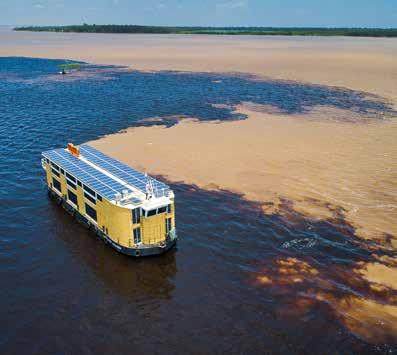
The local culture has indigenous in -
fluences from the native people, as well as European and African influences, which is also reflected in the Amazonian folklore and its traditions, in addition to composing and demonstrating the characteristics of the region as elements of the formation of the Amazonian identity.
When it comes to nature, the “Meeting of the Waters (pt: Encontro das Águas)” of the Negro and Solimões rivers, intangible heritage of Manaus, is one of the most popular tours by tourists and visitors.

Manaus is also home to the Teatro Amazonas, one of the most important theaters in Brazil and the city’s main postcard. The monument has an “art nouveau” style architecture and harmonizes with other nearby buildings, all built during the Rubber Cycle, when the Amazonian capital was the economic center of the country.
Other attractions of the capital that cannot be overlooked are the Adolpho Lisboa Municipal Market, the Amazon Museum (MUSA) and the Seringal Museum, as well as The Metropolitan Cathedral of Nossa Senhora da Conceição, the Palácio Rio Negro Cultural Center and the Municipal Clock (recently restored), all in the Historic Center of Manaus.
Also noteworthy is the Janauari Reserve, home to the main species of Amazonian flora, such as the water lily and the samaumeira, a leafy tree typical of the Amazon floodplain that serves as a shelter for the inhabitants of the forest.
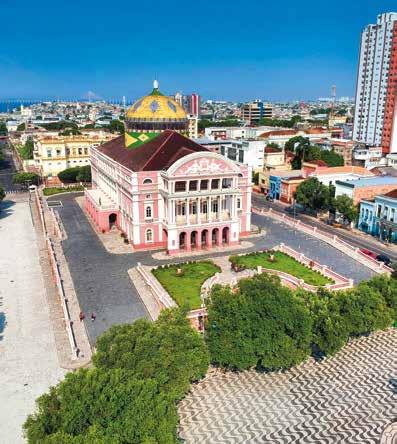
Manaus is the capital of Amazonas and is located basically in the middle of the Brazilian Amazon, in the largest state in Brazil. The city is endowed with Tourist Assistance Centers - CATs, where the labor is formed by tourism students from local universities, that are trained to receive the visitors in the best way.
1
routes can be taken in the city and outside it. As one of the main attractions we have Sport Fishing, with the tucunaré (a fish from the Amazon rivers).
7
The city is blessed with incomparable and unique natural beauty, with natural attractions such as the Meeting of the Waters (Rio Negro and Solimões) and the Tupé Sustainable Development Reserve; urban parks, as well as exuberant flora and fauna in inspiring scenarios. 3
2
The Historical Center conserves houses with architecture from the rubber boom cycle, which occurred in the late nineteenth century and early twentieth century. Some centennial buildings also house cultural tourist equipment that conditioned Manaus to be, at that time, one of the richest cities in the country.
To sail on the Amazon rivers is to be dazzled by magnificent sunsets and sunrises, which complete a perfect scenery for contemplation of nature, accommodated on cruise ships, on “gaiolas” (regional transport boats between cities in the interior of the state), on luxury yachts or on boats that offer overnight itineraries.
8 Manaus has new hotel developments that offer accommodation in boutique hotels, charm hotels, hostels, international category hotels offering luxury, comfort, modernity and quality. There are also hotel developments of large national and international chains in the city.
4
It has several important archeological sites, which help to identify the origin of the people who inhabited the region thousands of years ago, as you can see at the City Museum - MUMA.
9 In the city’s Historical Center, you can enjoy several restaurants that offer a diverse cuisine, with dishes based on typical regional fish, such as tambaqui, pirarucu, tucunaré, jaraqui and pacu. It is worth a gastronomic tour around the city to try spices and regional fruits like cupuaçu, mari mari, tucumã, pupunha, sorva, among many others.
5
Manaus is inserted in the international route of great shows that are presented in emblematic spaces like the amphitheater of the Tourist Complex of Ponta Negra, the Arena da Amazônia and the Sambódromo.
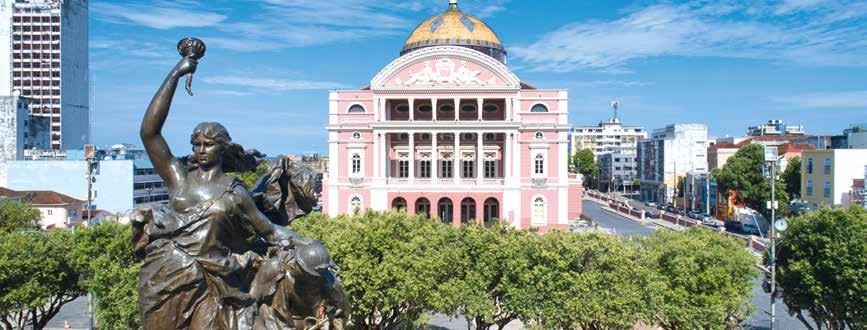
6
The city offers countless options for the practice of Nature Tourism, Experience Tourism and Ecotourism. Several tourist
10
Modern tourist equipment offer entertainment and leisure, enabling the visitor to program to experience Manaus for five days or more. Highlights include the double deck tourist bus, the Amazonas Theater, the Palace of Justice, the Rio Branco and Rio Negro Palaces, the Rio Negro Bridge, the City Museum, the Adolpho Lisboa Municipal Market, the Amazon Peoples’ Cultural Center, among others.
Photo: Ivo Brasil Filho
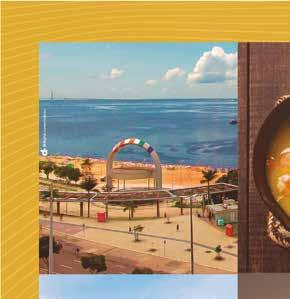
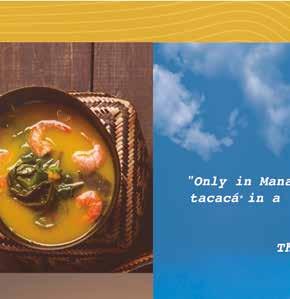




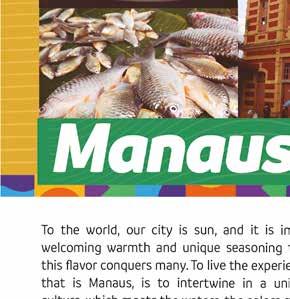





Pará stands out for its vocation for Ecotourism, as it covers part of the Amazon Forest. Its territory is marked by regions of Mangrove and Cerrado, in addition to having the coast bathed by the Atlantic Ocean. Its formation has a strong contribution from Portuguese, French and Japanese influences.

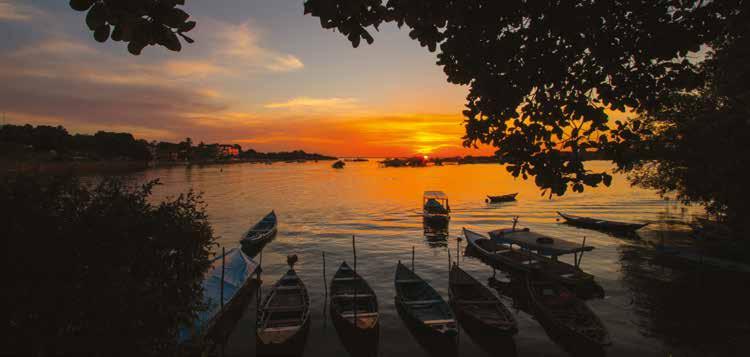
In addition, Pará is home to approximately 31 indigenous ethnicities, which, in part, are responsible for the strong influence on Pará cuisine, which is characterized by the use of fish and leaves (chicory, coriander, in addition to maniva – ground manioc leaves), hot peppers, local herbs and fruits.
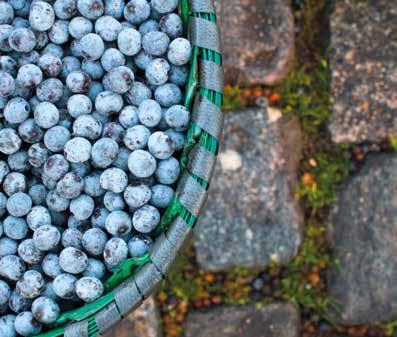
The capital Belém is a city located in the bay of Guajará. Among its tourist attractions, the Estação das Docas is one of the most popular, a place that houses a gastronomic complex that has also become a meeting point and sunset observation point.
However, the Ver-o-Peso Market, considered one of the oldest public markets in the country, elected one of the 7 Wonders of Brazil, is the biggest postcard of Belém. It brings together the Iron Market, the Fisherman’s Square,

the boat dock and the largest open-air market in Latin America, which offers regional and exclusive spices, food, herbs and medicinal products.
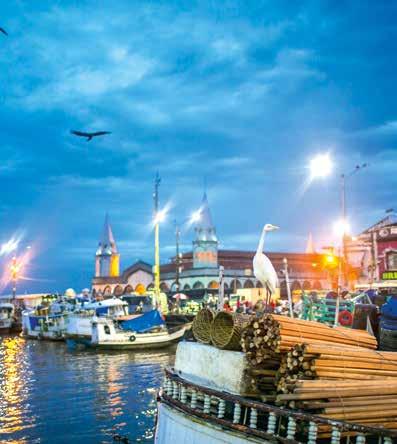
Your itinerary through the capital should also include the Museu do Forte do Presepio, the Mangal das Garças and the Theatro da Paz, a neoclassical building inspired by the Scalla in Milan.
The city is also known for its vocation for religious Tourism, especially with the Círio de Nazaré, an event that takes place for 15 days in October, when the pilgrimage held on the second Sunday of the month happens.


Rich cultural identity. Natural Beauties. Exquisite cuisine. More than 185 kilometers of beaches. A hospitable people. This is Pernambuco, which invites all European and foreign tourists to truly “Pernambucar” and discover everything the state has to offer. Pernambuco is a place of beach, sun, heat, coconut trees, high quality gastronomy, culture and a lot of history in a single place. The flagship there are the beaches, but the truth is that from the coast to the Sertão, the state offers its admirers an attractive combi-

nation of culture and modernity.
Pernambuco breathes, lives and always reinforces its traditions and customs. Whether it’s Carnival, June festivals or even in low season, no matter what time you decide to visit the state, you’ll certainly be enchanted by the rhythm of Frevo, Maracatu and the taste of the delicious roll cake. From the capital to the interior, the destinations offer natural beauties, gastronomic and artistic riches characteristic of all the people of Pernambuco, starting, of course, with the capital Recife.


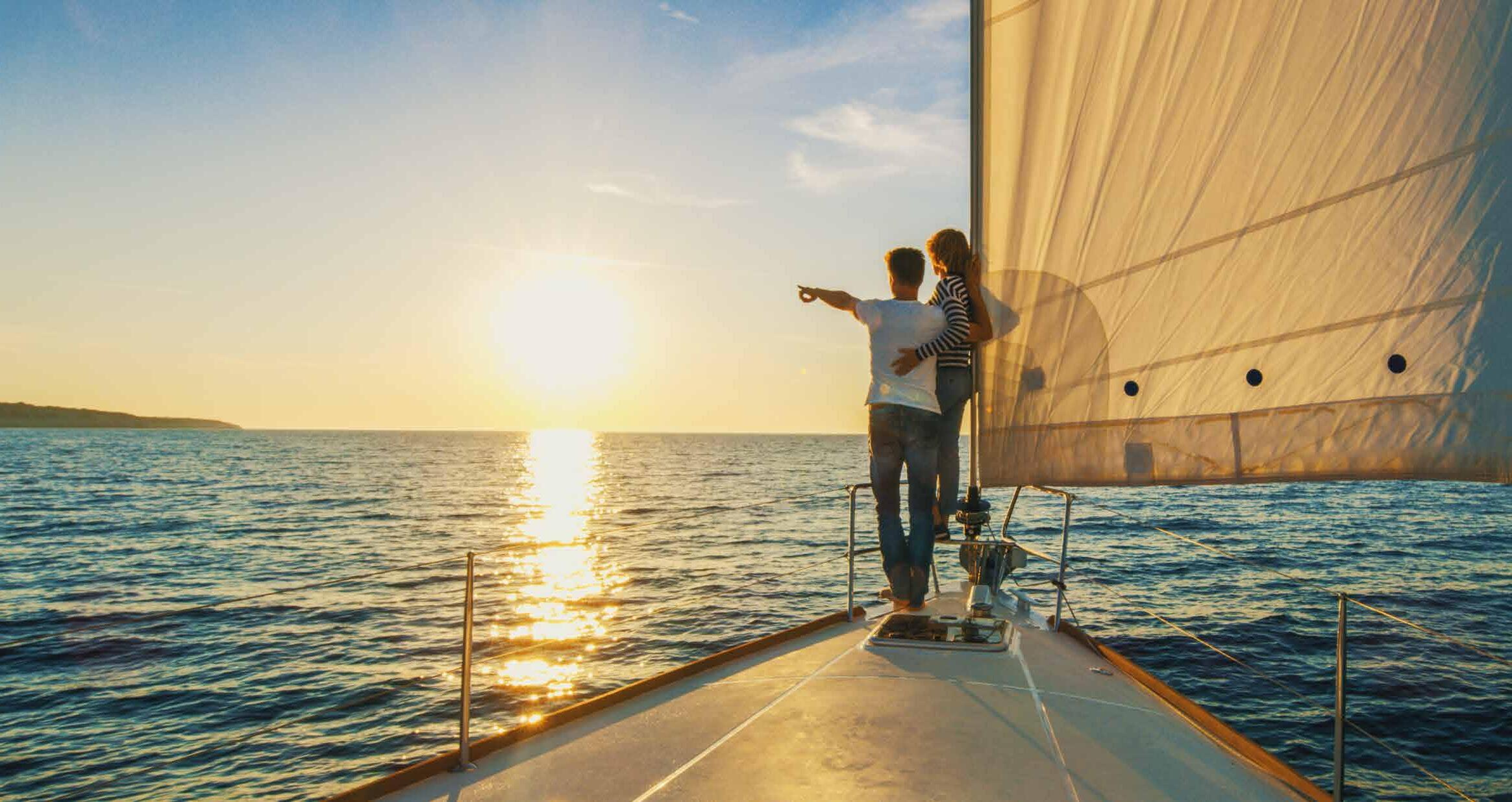
“I came back, Recife. It was nostalgia that took me by the arm.” One of the great Brazilian singers and songwriters, Alceu Valença, immortalized the capital of Pernambuco in his music. In the song, Alceu tells a little about Recife’s culture, such as the Frevo power, and highlights precisely the nostalgia he has for Recife. So this is the first tip: if you are going to visit Recife, get ready, because the longing to come back is very strong. It really is a captivating city. There, the sun rises very early, an invitation to enjoy beaches, rivers, green areas and historic buildings.
The beaches most sought after by tourists in the region are Boa Viagem and Pina, which have shores with many coconut trees, in addition to a sea of warm, greenish waters. From Boa Viagem to Recife Antigo, which has Rua do Bom Jesus as a reference, Recife has a lot to surprise. There are churches, colonial houses and museums that keep the rich history of the state. The metropolis also has an infinity of restaurants specializing in seafood and a lively nightlife, rocked by the rhythms of Pernambuco.
Gastronomy is a separate chapter, with typical elements, including seafood, beef jerky, green beans, the aforementioned roll cake, coalho cheese, among others.
We have one last tip. To the sound of frevo, maracatu, afoxé, samba, pop and so many other rhythms that characterize the unique diversity of Brazilian culture, plan to discover the Carnival of Recife. For more than a month, the city celebrates the Carnival Cycle, honoring its cultural traditions. There are more than two thousand presentations distributed in more than 60 carnival centers. The highlight of Carnival, of course, could not be different: the gigantic block of Galo da Madrugada, which literally drags millions of Pernambuco and tourists through the streets of downtown Recife as soon as the sun rises. It is normal to wake up very early to enjoy the most famous block in the city. In addition to it, parties spread throughout the city, such as Pátio de São Pedro, Marco Zero, Praça do Arsenal da Marinha and Avenida Guararapes. Considered the biggest block in the world, Galo da Madrugada always parades on Carnival Saturdays.






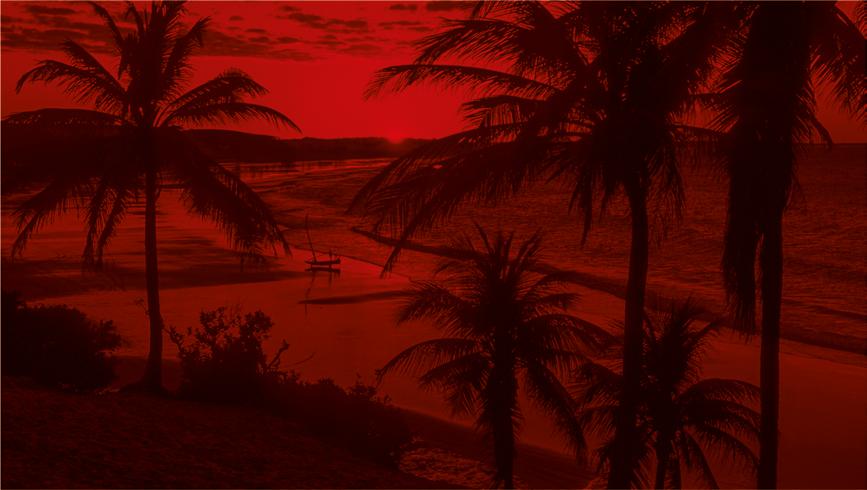




With the longest coastline in Brazil, Bahia offers 1,200 kilometers of coast and more than 300 beaches, in addition to natural and historical tourist attractions that make the state very popular for Brazilians and foreigners. There are several festivities throughout the year, with emphasis on Carnival, religious festivals and New Year’s Eve.

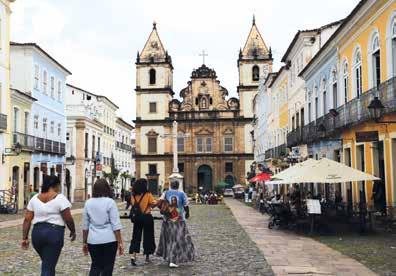

However, there is more. Diversity, history, many places to visit and many cul-
tural attractions to discover make Bahia one of the most colorful and culturally rich states in Brazil. In addition to encompassing different ethnicities, religions, flavors and colors all in one place, Bahia is full of historical context and outstanding cuisine. Governors, mayors and secretaries, no matter the management, usually say that there is a Bahia for each one because of such cultural and tourist diversity that exists in the state.
Salvador has several beaches recognized by national and international tourism. Lets pretend you already disembarked, checked into your hotel, put on your bathing suit and put on your sunscreen. Now, let us get to know the coastal highlights together, starting with Praia da Barra. The calming and clear waters are very popular with locals and foreign tourists - always remember this if you have children with you.
As we continue our panoramic trip along the shore, we arrive at Ondina Beach. Its reefs create natural pools, so you’ve know it, right? It is peaceful all day long. And who never wanted to spent an afternoon in Itapuã? In the sun that burns in Itapuã? With weak waves, the paradisiacal scenery was immortalized in the songs of the Brazilian artists like Toquinho and Vinícius de Moraes.
Salvador is also home to cultural diversity and carries an undeniable historical background. Pelourinho, considered Cultural Heritage of Humanity and listed by Unesco in 1985, is located in the Historic Center of Salvador, characterized by a square surrounded by old
houses and churches. Speaking of the historic center, Salvador is now proud of its region, which has been revitalized in the last decade and has gained several attractions, such as Casa do Carnaval, a true immersion in the history and culture of one of the most important festivals for the state and the country.
One of the most popular churches in Salvador is in the neighborhood of Bonfim, more specifically in a place called “Sacred Hill”. The Basilica Church of Nosso Senhor do Bonfim is known mainly for the colorful cloth ribbons that, according to tradition, grant three wishes to those who tie them to their wrists or ankles.
Another attraction of the city is the Elevador Lacerda, National Historic and Artistic Heritage that was built in 1869, with 72 meters high and two towers. The Elevator was designed to unite the upper and lower parts of Salvador. For those looking for sun and beach, the tip in Salvador is to visit the Farol da Barra (Barra Lighthouse), which houses one of the most famous postcards of the city, as well as the Baía de Todos os Santos, also known as the Blue Amazon, due to the immensity of sea that exists there.
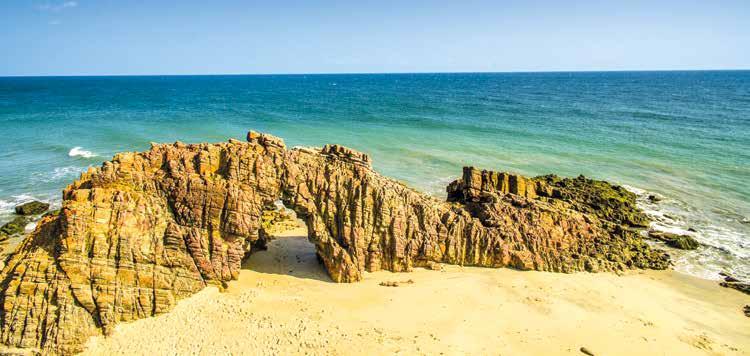
Ceará, a state of the Northeast region, is known for its beautiful beaches, which attract the interest of tourists from all over the world. The local culture is the result of the influence of indigenous and Africans, as well as Europeans. Handicrafts are one of the main cultural expressions in the state and are commonly made with leather, straw, clay, wood or sand.
There is also cordel literature and woodcuts, which tell stories in the form of verses. The cordel was even recognized as a Brazilian Intangible Cultural Herita-
ge. In terms of parties and nightlife, the Reisado, the Caninha Verde Festival, the Festas Juninas and the Festa da Banda Cabaçal are very popular in Ceará.

The gastronomy is rich and makes massive use of fish, all kinds of seafood, dried meat, cheese, cassava manioc and lots of seasoning. When visiting Ceará it is mandatory to taste dishes such as couscous, baião de dois, moqueca, cashew sweets, rapadura and, of course, tapioca. The typical drink Cajuína is also found in great abundance in the state.

Fortaleza has a plurality of tourist options, whether in contact with nature or cultural, there are many attractions. Among the most famous places are Praia de Iracema, Praia do Meireles, Praia do Futuro and the Historic Center.

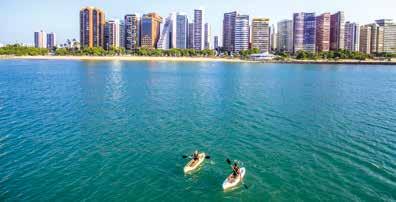
Theatro José de Alencar is one of the main tourist attractions in Fortaleza and a symbol of Ceará art. It is possible to take a free guided tour for about an hour. It is also worth including in the itinerary the Dragão do Mar Center of Art and Culture, a space that houses the Ceará Culture Museum; Ceará Contemporary Art Museum; a cinema; the Rubens de Azevedo Planetarium and an Amphitheater, where several free performances of the most diverse artistic genres are held.
Praia do Futuro, with its bathing facilities and innumerous tents, has established itself as a mandatory stop for anyone visiting Fortaleza. There is also Praia de Iracema, which is one of the most popular places in the capital. The place has a pier popularly known as Espigão da Praia, where you can watch the sunset.
For those who want to buy handcrafted products, in addition to the city’s street fairs, one of the options is to go to the
Ceará Tourism Center, where there are fabrics, lace items, bags, needlework and much more. Do not miss the Feira de Artesanato Da Beira Mar, a 30 year old spot located outdoors and which has stalls with several products, from clothing to food.
Other alternatives are to visits the Metropolitan Cathedral of Fortaleza, the Central Market and the Fish Market, located on Mucuripe Beach, where you can find fishermen’s stalls and restaurants. The option is ideal for those who want to taste dishes with seafood at inviting prices.
With an emerald sea, Alagoas has 235 kilometers of coastline full of white sand beaches and crystalline waters. The North Coast is also known as the Coral Coast, as it has the second largest barrier reef in the world, with 130 kilometers highlighted by the green of the coconut trees and the turquoise blue of the sea. Despite being the third smallest Brazilian state and having only 3.5 million inhabitants, Serra da Barriga alone,
where the Quilombo dos Palmares Memorial Park is located, has been visited by almost 7,500 people from 16 countries since it received the title of Cultural Heritage of Mercosul.

Among the tourist attractions, Maceió, the capital, Maragogi, Japaratinga, Barra de São Miguel, as well as Piaçabuçu, Marechal Deodoro and Piranhas stand out. Alagoas cuisine is a show apart, with many dishes based on fresh seafood.


Maceió, the capital of Alagoas, has the Zumbi dos Palmares International Airport as its gateway, which refers to the Quilombo dos Palmares Memorial Park, a place that reconstitutes the scenario of the largest, most enduring and most organized refuge for enslaved blacks in the Americas, where Zumbi dos Palmares, the leader of the resistance, lived in the 17th century. The attraction is located about 88 kilometers from the city center, or approximately two hours by car.
Despite the historical and cultural wealth, it is the sun and the sea that catches the eyes of the tourists. Due to its geographical position, the sun rises shortly after 5 am and sets around 6 pm, so the tip is to wake up very early and dive into the green waters of the sea, as in Ipioca Beach, which is 20 kilometers away from the city center. The beach has an extensive strip of reddish sand, with strong waves and sandbanks. There is also an on-site beach club and a viewpoint, in addition to the home of Marechal Floriano Peixoto, the second
president of Brazil and an important figure in the country history.
Another famous beach is Ponta Verde, considered the most beautiful in the city. The tourist spot is a nice option for windsurfing, in addition to floating in the natural pools that forms at slow tide. The beach structure is also a nice feature, with a nice bike path. Cruz das Almas, located 6 kilometers from the center of Maceió, is the stage of local, regional e national surf competitions. The area also has a complete hotel and restaurant chain.
Jatiúca Beach can’t be left out of your itinerary either. Separated from Cruz das Almas by Lagoa das Antas, it has rough seas and is known for its infrastructure and entertainment offer. There are several bars, restaurants, hotels, concert halls, stores, galleries and space for sports.
Considered one of the most popular in the entire state, Pajuçara beach also has a good structure of hotels, inns and restaurants and is a great option for families. In addition to the nautical activities, one of the most attractions is its nightlife, with clubs, bars and restaurants.
Located in the Brazilian Northeast, Rio Grande do Norte is a state with about 3.5 million inhabitants distributed in 167 municipalities, many of which stand out for tourism. With an area of 52,809 square kilometers, the state borders Paraíba and Ceará.
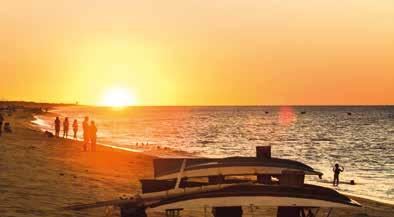
With a tropical climate, Rio Grande do Norte has vegetation predominantly belonging to the Caatinga, in addition to formations of Mangrove, Restinga and Atlantic Forest. During its colonization passed some European immigrants, es-


pecially Portuguese, French and Dutch, as well as indigenous natives and African populations, influencing the local culture.
The city of Natal, capital of Rio Grande do Norte, is the birthplace of postcards such as Morro do Careca, located on Ponta Negra Beach, Barreira do Inferno and Forte dos Reis Magos. The city is also home to Parque das Dunas, the second largest urban park in the country. The attraction is also recognized by Unesco as an integral part of the Brazilian Atlantic Forest Biosphere Reserve.

As we mentioned above, there is no shortage of attractions in the state capital. Forte dos Reis Magos is a military building built in 1949 to protect the Portuguese who were in conflict with the French and the Indians. At the site, which is on the banks of the Potengi River and is also the city’s first construction, it is possible to find artifacts from the time when it was active.
You cannot miss the Mercado da Redinha, which is located on Praia da Redinha, at the mouth of the Potengi River, and which is considered an intangible heritage of Natal or even the contemplation of the sunset during the catamaran ride on the same river. On Pirangi beach is also the largest cashew tree in the world. It has an area of approximately 8,500 square meters of canopy and produces about 2 and a half tons of fruit per harvest.
In the West Zone, there is the Costa Branca, a region that is home to virgin beaches, where the vegetation of the hinterland meets the sea, colored by the dunes and cliffs. Among the highlights are Soledade beach, in the oil prospecting area. It has a different look, a result

of the constant burning of gases from oil exploration. At night, the fire torches become a tourist attraction.
Close to Ponta Negra, Barreira do Inferno, the Brazilian Air Force Base, is the first in South America for rocket launches and draws attention for its vibrant red tone at dawn, which reflects the sun’s rays into the sea. The name was given to the cliffs by local fishermen. The attraction is on Rodovia RN 063 Km 11, in the city of Parnamirim, in the Metropolitan Region of Natal.
Everyone knows that Brazil guarantees one of the best experiences with nature. What you may not know, is that it is possible to enjoy Brazil’s natural exuberance very close to large urban centers. That’s right! Ilhabela

is about 200 km from São Paulo and only 3 hours from the Guarulhos International Airport. Besides this convenience, find out 10 reasons to visit this paradise and fall in love with the destination. 1
More than 40 paradisiacal beaches. There is no lack of options. You can go by car or bike, take an off-road trip to Castelhanos Beach, venture out on a trail to Bonete Beach, or simply be enchanted by the landscape on a boat ride to isolated beaches. 2
94% of Ilhabela is covered by Atlantic Rainforest. In harmony with nature, our trails lead to dozens of waterfalls where it is possible to refresh and renew your energy. Those who prefer to overcome limits and conquer one of the highest points on the island can hire a local guide and do the Pico do Baepi Trail, from where you have a panoramic view of over a thousand meters high. 3
If the underwater universe fascinates you, try having contact with different species of fish, turtles, rays and starfish. There are 15 dive sites, including historical shipwrecks to explore.
da Toca are excellent options. The Fazenda Engenho D’água is also a must-see. A heritage site protected by IPHAN and CONDEPHAAT, the place is one of the most important and best preserved sugar cane mills on the Brazilian coast.
7 Bon appetite! The flavors of the island also deserve to be highlighted. Live a gastronomic experience, filled with dishes from the local or international cuisine. There are more than 200 bars, cafes, and restaurants to please the most demanding palates.
8
Say the long-awaited “I do”! The archipelago is a reference for couples from all over Brazil, so much so that an average of 22 weddings a month are held on the island. Ilhabela has everything necessary for unforgettable ceremonies and parties by the sea, in contact with a lot of nature.
4
The diversity of birds surprises with their songs and colors. Take advantage of our guides’ knowledge and practice birdwatching. There are more than 390 species of birds on land and sea.
5
Speaking of the sea, whale and dolphin watching is an unforgettable experience. From June to August, Ilhabela is on the route of the humpback whales and they put on a real show. Book your trip with our receptive agencies.
6
Experience the charms of culture. Visiting the Nautical Museum to find out about our shipwrecks or getting to know the last sugar cane mill in operation on the island at Cachoeira
9
The comfort of the island’s hotels and inns will win you over. There are more than five thousand beds to guarantee the experience you are looking for. From rustic lodgings integrated with nature to high standard hotels with the best seaside experience. Everything to make you feel comfortable, warm and welcomed.
10
Taking advantage of the city’s events is an invitation for the whole year. With a programming always thought for fun, Ilhabela moves the life of those who visit it with lots of entertainment, culture, sports and gastronomy. Enjoy!
Photo: SecTurFrom exciting hiking trails to nature’s rarest species. In Ilhabela, everything is preserved to be unforgettable. Experience being surrounded by nature everywhere.
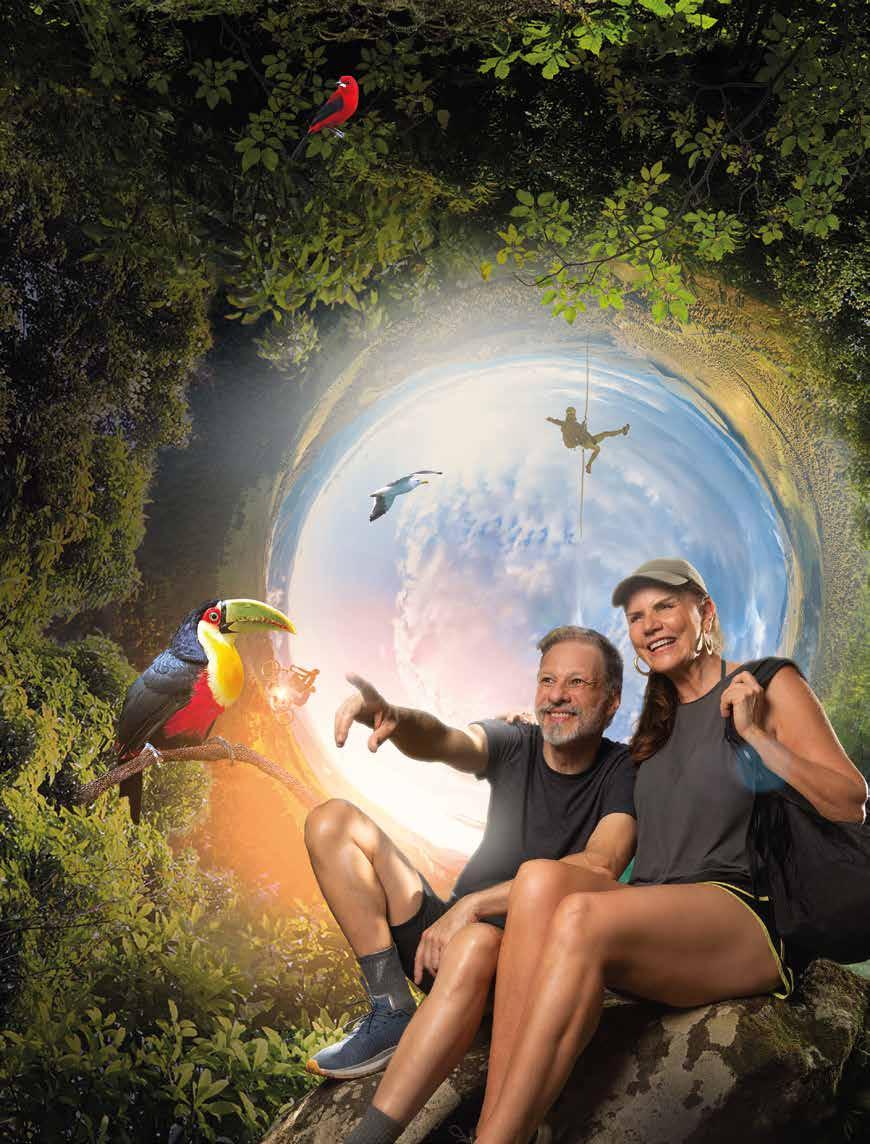
Discover the wonders of Ilhabela turismoilhabela.com

Located in the Southeast Region of Brazil, the State of São Paulo borders with Rio de Janeiro, Minas Gerais, Mato Grosso do Sul and Paraná. The capital is the city of São Paulo, the largest urban center in terms of population in Brazil. São Paulo has a diversity of landscapes,

services and tours. The possibilities range from countryside landscapes, waterparks and thematic/amusement parks, beaches, waterfalls, main cities, museums, events and lots of business, which makes the state the most abundant destination in Brazil.


São Paulo is for everyone and anyone! It is the perfect place for those who love nature, as well as those who love gastronomy and culture. Known as the financial center of Brazil, the capital is a major entertainment center, and also the richest city in South America.
There are many options for dining and nightlife spots. Avenida Paulista, for example, is one of the postcards of the capital and reunites several activities options, such as visiting the MASP (The São Paulo Museum of Art) and the viewpoint in Sesc Paulista. On Sundays the avenue is closed to cars and people can walk around and enjoy it as well as practicing sports such as cycling. Paulista Avenue is the stage for cultural agitators, artists and sellers of all sorts of products, objects and services.

The destination is also home to a rich architecture, with emphasis on the Marti-
nelli and Copan buildings, the colonial-style church known as Pátio do Colégio, The New Museum of the Portuguese Language, MASP and Paulista Avenue itself.
Among the tourist activities, the most common in “Sampa” - affectionate nickname of the city, is to enjoy the restaurants, discover the cultural diversity that can be found in every neighborhoods, such as Liberdade, Moema, Vila Mariana, Vila Madalena, Itaim Bibi, Pompeia and Pinheiros, and enjoy the nightlife, which also extends to the ABC Region.
Currently, a MUST GO place, among so many other cultural and tourist attractions that the city of São Paulo offers, is the recently reopened Ipiranga Museum. After nine years closed for restoration, recovery of part of the collection and expansion, the Museum reopened its doors to the public in September 2022, with an exhibition area three times larger than when it closed, back in 2013.
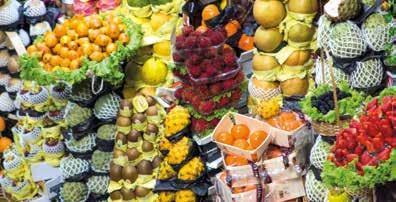
A 630 km coastline of incomparable beauty with several seaside sports options, the State of Rio has always been the gateway to tourists looking for more leisure and fun in Brazil.


The Mountain Region has its own culture, lower temperatures, waterfalls and natural beauties. Costa do Sol stands out with its popular beaches and cities
well-known by tourists, such as Búzios and Arraial do Cabo. Costa Verde enchants for its ability to unite crystalline waters with large mountains of the Atlantic forest in several cities, such as Angra dos Reis and Paraty. Vale do Café impresses with all its history and culture from the rich coffee production on its historic farms.
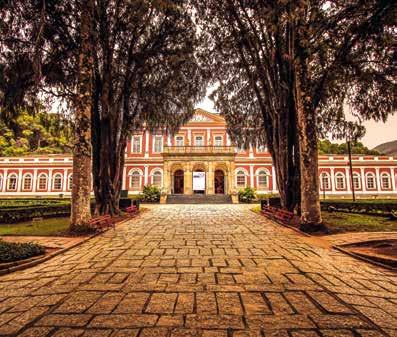

Rio de Janeiro is a large Brazilian seaside city, famous for the beaches of Copacabana and Ipanema, the statue of Christ the Redeemer at the top of Corcovado, and the Sugar Loaf Mountain, a granite peak that you can climb with cable cars. People who visit the destination can party in the neighborhood of Lapa and still take beautiful photos in the neighborhood of Santa Teresa.
In addition to the most famous beaches, you should also visit Prainha and

Macumba beach. For surfers, the tip - with no margin for error - is Arpoador beach, which has a large rock from where you can see the sun setting between the amazing Morro Dois Irmãos.
For those who like sports, visiting Maracanã, one of the best-known football stadiums in the world, and Porto Maravilha, are mandatory tours. Porto Maravilha, by the way, now houses the new cultural and entertainment attractions for cariocas and tourists, such as the Museum of Tomorrow, AquaRio and Yup Star, the largest Ferris wheel in Latin America.
The State of Minas Gerais draws attention for the beauty of its parks, squares and ecological refuges.
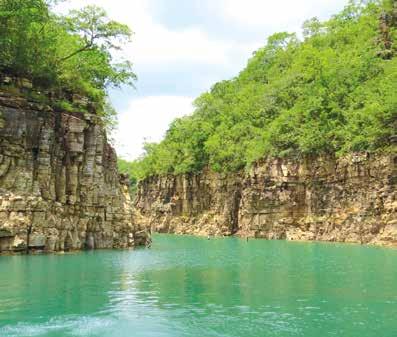

Minas Gerais has always been a key part of Brazil’s economic development, both during the Gold Rush and afterwards, in the immense and well-known coffee plantations. Today, it is the main piece for those who seek culture, history
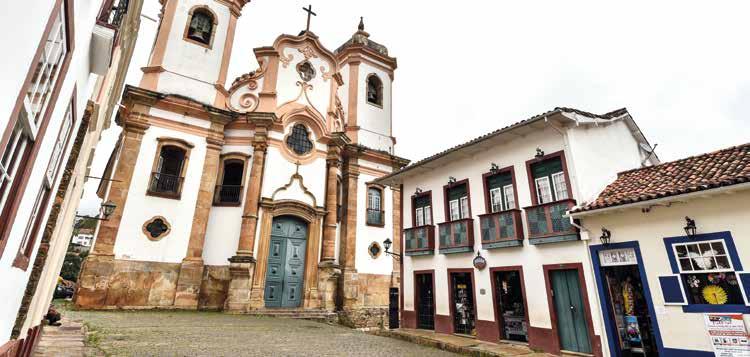
and good gastronomy.
In addition to fitting into several national and worldwide tourism trends, Minas Gerais creates its own trends. Through the year of mining, the intrinsic attributes of what it means to be a miner are valued and presented to tourists, enriching their roots and preserving knowledge and skills.

In Belo Horizonte, the options for those who enjoy nature, cultural and historical heritage are endless. There are museums, cinemas, parks, theater, mountains and observatories to be explored during the day. At night, world capital of bar is always full of beautiful and cheerful people.
‘Beagá’, as it is usually called, has several attractions in its urban landscape, especially the Architectural Complex of Pampulha and Praça da Liberdade. In Pampulha, one of the main

attractions is the Church of São Francisco de Assis, a postcard of the city and one of the nicest piece of work of the famous architect Oscar Niemeyer. The circuit is so beautiful and special that Unesco recognized it as a World Heritage Site.
Another outdoor tour tip is the Pampulha Ecological Park. The Liberdade Circuit, created in 2010, is also another important tourist attraction in the capital. You should also visit the Palácio da Liberdade, the House of Cultural Heritage of Minas Gerais and the Academia Mineira de Letras.






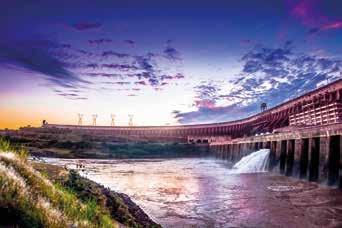
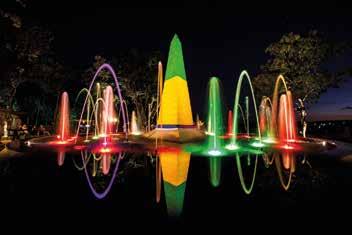



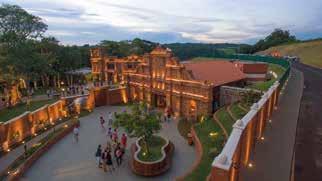

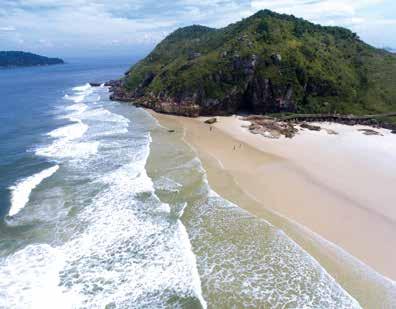


The State of Paraná, located in the south region of Brazil, is home to one of the seven wonders of nature, the Iguaçu Falls and the most ecological capital of Brazil, the city of Curitiba. Paraná is a complete destination, with attractions ranging from beaches to large cosmopolitan urban centers, beautiful mountains to imposing waterfalls. The destination has a rich biodiversity and tourist
attractions divided into 14 regions.
The local gastronomy also deserves attention. It is possible to delight yourself with the famous “Barreado”, a typical dish of the coast of Paraná, which is composed of a beef stew cooked in a clay pot, served with manioc flour, banana and rice. Another dish worth mentioning is the ground rib, in addition to several recipes made with Pinhão, a seed typical of the region.
The capital Curitiba does not disappoint when it comes to tourism attractions. Cosmopolitan, technological and extremely sustainable, the destination is a true mecca of culture, history, architecture with lots of indoor and outdoor leisure options. Among the main tourist attractions in the city are the Panoramic Tower, which has an observatory at the top; the Ópera de Arame, a tubular steel structure with a transparent roof; the Oscar Niemeyer Museum, the Holocaust Museum, the Egyptian and Rosacruz Museum.
The great postcard of the destination, however, is the Jardim Botânico de Curitiba, one of the most visited tourist spots in the city, opened in 1991. The Botanical Garden is made up of an iron construction with 3,800 pieces of glass, which works as a greenhouse for countless plant specimens from Brazil and other countries. In the outdoor area, the landscape is complemented by the charming, well-kept geometric gardens, as well as fountains spread throughout the 245,000 m² park. It is the ideal place to have an outdoor picnic and recharge your batteries in the

middle of the urban center.
In fact, there is no shortage of parks and open and green areas in the city. In Barigui Park, one of the main ones in the capital, it is possible to find capybaras living by the lake. Tanguá Park is the best place to watch a beautiful sunset. Bosque Alemão also has its own charm, ideal for hiking and relaxing with a nice breeze.
In the architecture and in the local cuisine, it is possible to perceive a strong European influence, which is also reflected in the city’s open fairs, such as the Feira do Largo da Ordem, located in the historic center of the city, which also has numerous options of things to do. Finally, the Batel neighborhood is the perfect place to enjoy the nightlife and have a good beer or a nice cocktail in the bars.

The State of Santa Catarina is considered one of the main tourist destinations in Brazil for several reasons. Beautiful beaches and natural landscapes, cultural attractions and amusement parks are some of the options in the state, which is located in the south of the country. The seasons in the region are well defined and influences the activities to be chosen by visitors.
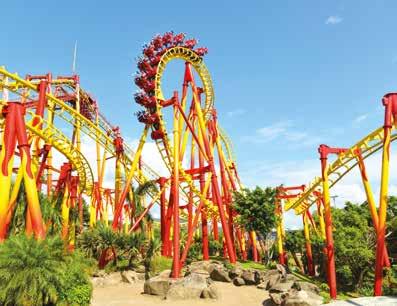
In summer, the tip is to visit the state’s beaches. The coastline is 560 kilometers long and has ideal scenarios for the practice of water sports such as surfing, windsurfing, kitesurfing and stand up paddle. Santa Catarina also offers tours that can involve snow and even whale watching, so it is a must-see destination for anyone visiting Brazil.

One of the great gateways for tourists arriving in Brazil, Florianópolis is known for its many beaches, from the most popular ones such as Jurerê, Jurerê Internacional, Joaquina and Ingleses, to the more private ones such as Praia do Forte, Lagoinha, Mozambique, Brava, Ribeirão da Ilha, Shipwrecked and Armação.
Florianópolis also offers many historical attractions, including the sites of the original Azorean settlers, Lagoa da Conceição and Santo Antônio de Lisboa, which are worth a visit. Throughout the year, there are also several events in the city that deserve to be highlighted for
their peculiarity, economic relevance and consistency, such as the National Oyster Festival, for example.
The Hercílio Luz Bridge is the most famous symbol of the capital and is worth a stop at its viewpoint, located at the head of the bridge, from where you can have one of the most beautiful panoramic views of downtown Florianópolis. Praça XV de Novembro, the main point of convergence of the city, is a must see, as well as the historical buildings in its surroundings.
Other must-visit points are the Florianópolis Public Market, the Morro da Cruz observatory, the Dunes in Joaquina Beach, Lagoa da Conceição and the natural pools of Barra da Lagoa.


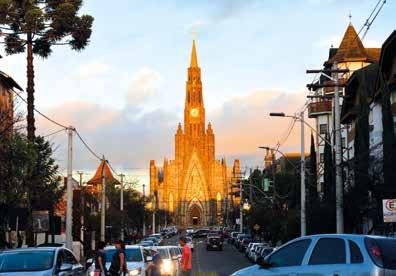

Rio Grande do Sul offers excellent hotel infrastructure and several options of restaurants that carries the characteristics of the local gastronomy. Mixing urban and natural landscapes, the state has lots of cultural activities, adventure sports options and beautiful landscapes to be observed. With temperatures below the country’s average, it is in Rio Grande do Sul that tourists can find a good place to enjoy the cold
weather. For this reason, mate, barbecue and wine consumption are so popular in the state.
However, that’s not all. Rio Grande do Sul also offers several options of rustic and urban beaches, such as Praia Grande, Praia da Cal and Arroio do Sal, among others. In addition, the destination is equipped with port and good air infrastructure, making the arrival at the state really easy.

The capital Porto Alegre is one of the most important in the country, full of culture, rich architecture and cutting-edge cuisine, in addition to a harmonious and complementary contrast between the natural beauties of its resorts and the great buildings of the cosmopolitan city.
Affectionately called POA, the capital has one of the most beautiful streets in the world, the Gonçalo de Carvalho street, located in the Independência
neighborhood. Completely wooded, the scenery is magical and guarantees a nice breathe in the middle of the stone jungle.
Your itinerary around the city should include Praça da Matriz, Usina do Gasómetro and Parque da Redenção. The Public Market, with more than 146 years of existence, is also a must, as it brings together all the ‘gaucho’ tradition. For those looking for outdoor walks and contact with nature, the Guaíba River, Parque Marinha Brasil, Moinhos de Vento, Parque Redenção and Farroupilha are the perfect options.
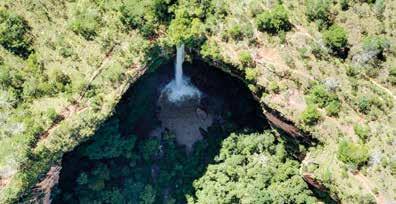
Amazon, Cerrado and Pantanal. These are the three biomes you will find in Mato Grosso. Covered mostly by the Amazon rainforest, ecotourism is a very strong attraction in the third largest state in Brazil, with countless crystal clear rivers, abundant fauna and flora, high-quality cuisine and a lot of culture and history.
Among the highlights of the gastronomy are the dried meat, served with green plantains and rice. The chicken with Pequi - a typical fruit of the region, the Mojica de Pintado - a famous fish of the Pantanal and


the Broth of Piranha, which is just mouthwatering.
With one of the hottest climates in Brazil, the destination reaches 107ºF, ideal for those who enjoy a little heat. Plenty of water, light clothes and sunscreen are essentials. Another great patrimony of the state are the indigenous tribes. There are more than 40 ethnic groups in Mato Grosso and, in some of them, it is possible to practice responsible tourism and learn more about the culture, cuisine, clothing and handicraft production of those tribes.

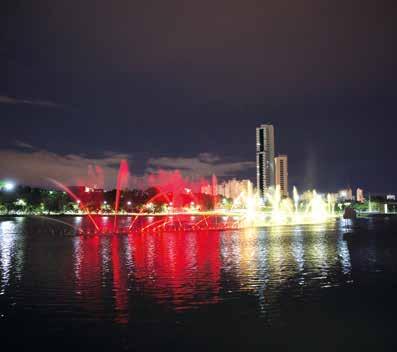
The capital, Cuiabá, is a travel spot that dates back to the 18th century gold rush. With a countryside atmosphere, tasty food, outdoor activities, cultural events, historic buildings, charming little churches, large parks, museums and much more. Cuiabá has a lot to offer to its visitors.
The city is much more than just a gateway to the Pantanal. The destination manages to mix its history quite efficiently, through its numerous buildings with preserved architecture and historical heritage, with modernity and all of the characteristics of an advanced big city.

In addition, it is possible to go back to the past on a walk along the Orla do Porto, located on the banks of the Cuiabá River. The street preserves a historic landscape with several colorful and charming buildings, which also function as bars and restaurants.
Another major attraction of the destination is its parks, especially the Tia Nair Park, which promotes an ecological tour and countless options for leisure activities and outdoor sports. There is also the Mãe Bonifácia Park, which offers a green contrast in the midst of the stone jungle and the Parque das Águas, which has a running track, waterfall, cultural presentations and the incredible Water Show - every day at 8 pm.
Untouched and exuberant nature, ecotourism, adventure tourism, rural tourism, fishing tourism and much more. The state of Mato Grosso do Sul, located in the Midwest region of the country, is made up of Serras, Cerrado, the largest floodplain on the planet and incredible scenery that make the destination unique.
The destination is full of natural attractions, such as waterfalls, caves, lagoons with crystal clear waters, state parks,

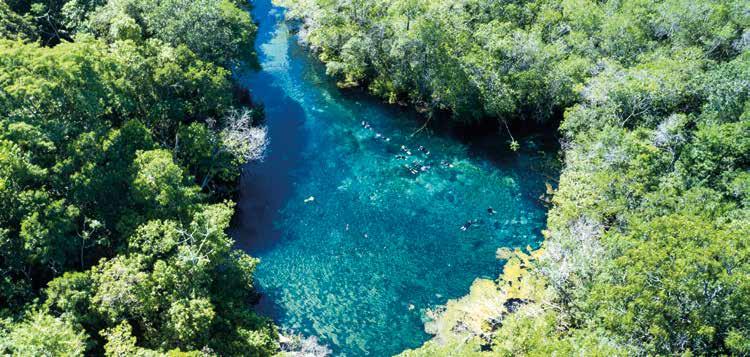
caves, sightings of wild animals, among many other must-see sights that make Mato Grosso do Sul a true paradise of nature.
The state also won the title of one of the ten best destinations in the world for sustainable tourism. Rich in culture and history, the destination offers the chance to discover more about the development of the region since the arrival of the first settlers.
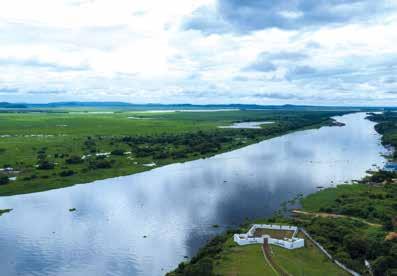

The capital and most populous municipality of Mato Grosso do Sul is Campo Grande. Located in a region of plateaus, the city has a breathtaking view and, due to the reddish color of its lands, it received the nickname of Cidade Morena. Among the attractions, the largest freshwater aquarium in the world, the Pantanal Bioparque, stands out. The attraction contains more than 7 thousand animals of 263 species, including fish, alligators and snakes in its 19 thousand square meters and 32 tanks. The focus of the tourist apparatus is to promote research projects and species conservation while entertaining and educating visitors.
With lively nightlife in contrast to the countryside feeling, the capital has numerous bars, restaurants, parties, museums, parks and monuments, such as
the Memorial of Indigenous Culture, a cultural center located within the Marçal de Souza Urban Indigenous Village. Campo Grande is also home to the Parque dos Poderes, where you can find, during a walk, different species of animals such as anteaters, birds and marmosets.
An unmissable point in the city is the Morada dos Baís, which was listed by the Municipality of Campo Grande-MS for its cultural importance for the capital. The cultural center is formed by a historic building that completed 100 years in 2018 and is recognized as the first masonry townhouse in the city. Morada dos Baís houses the interesting museum Lídia Baís, which brings together personal objects from the family and works by the artist, as well as temporary exhibitions and also has three rooms reserved for exhibitions, a space for musical performances and a restaurant.

Stage of remarkable moments in the history of Brazil, the Federal District carries the title of Brazilian federal capital and has Civic Tourism as its strength, mainly because it houses buildings and monuments related to the national political scenario.

With about three million inhabitants, the Federal District is divided into 30 administrative regions, called satellite cities, including Brasília. Its construction culminated in the miscegenation of cultures from all over Brazil, which


directly impacted local cuisine, culture and customs.
One of the DF’s vocations is the creative economy, which encompasses music, theater, dance, fashion and of course, tourism. The economic activity is primarily linked to the service sector, which corresponds to 71% of the workforce. However, tourism continues to advance and stands out more and more in generating employment and income since the 80s, according to data from the Federal Government.


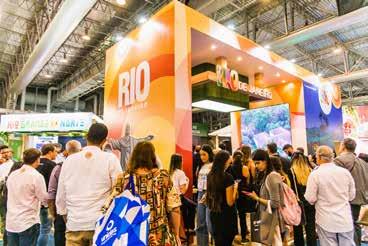


Considered a World Heritage Site by Unesco, Brasília is a city of unique architecture and format, planned and built from scratch, in the shape of an airplane. Some of the main buildings related to the political scenario like Palácio da Alvorada, the Itamaraty Palace, the National Congress and the Planalto Palace, seat of the Presidency of the Republic were designed and developed by the renowned architect Oscar Niemeyer. The buildings can be visited on specific days and times.
Oscar Niemeyer’s works provide visitors with an open-air museum. This is the case of the Metropolitan Cathedral of Brasília, which, in addition to being one of the best known churches in Bra -


zil, was also the first monument built in the city. Brasília also offers activities related to nature and extreme sports.
Parque da Cidade is one of the largest parks in Latin America and covers 40 hectares. For those who prefer water sports, Lake Paranoá is practically a freshwater beach and allows visitors to practice sports such as surfing, stand up paddle, canoeing, among others.
Another highlight of the city is the Brasília Capital do Rock Route, which pays homage important figures in the music scene in the 80. The route has 37 visiting spots that are part of the history of the city and the country and praise artists and bands such as Legião Urbana, Capital Inicial, Raimundos, Cássia Eller, among others.




































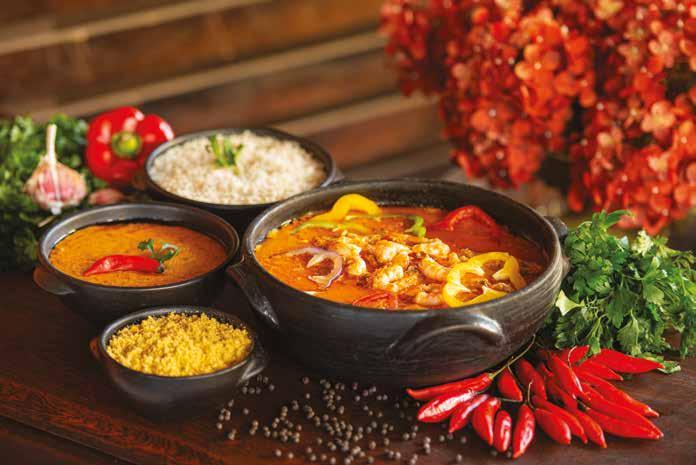
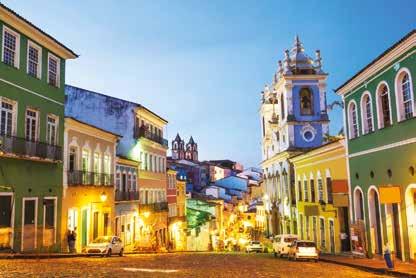


AirlineRatings.com has awarded TAP Air Portugal as the safest airline in Europe and the 6th worldwide.

TAP is the leading airline connecting Europe and Brazil, o�ering direct �ights from Portugal to:

• Rio de Janeiro
• Sao Paulo
• Brasilia
• Belo Horizonte
• Fortaleza
• Recife
• Natal
• Salvador
• Maceió
• Belém
• Porto Alegre